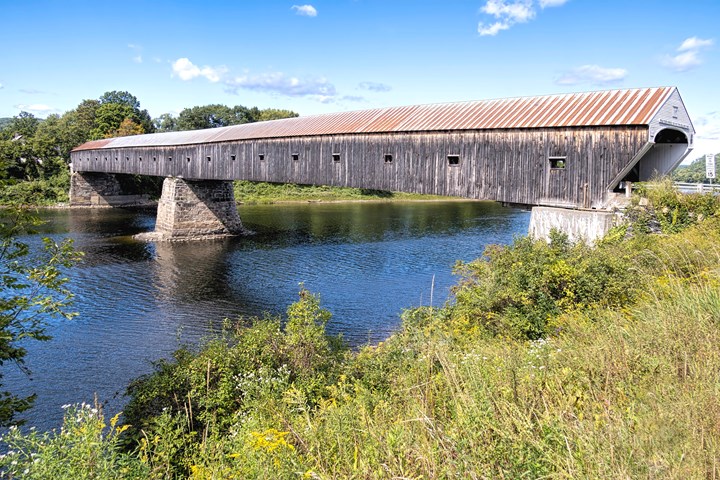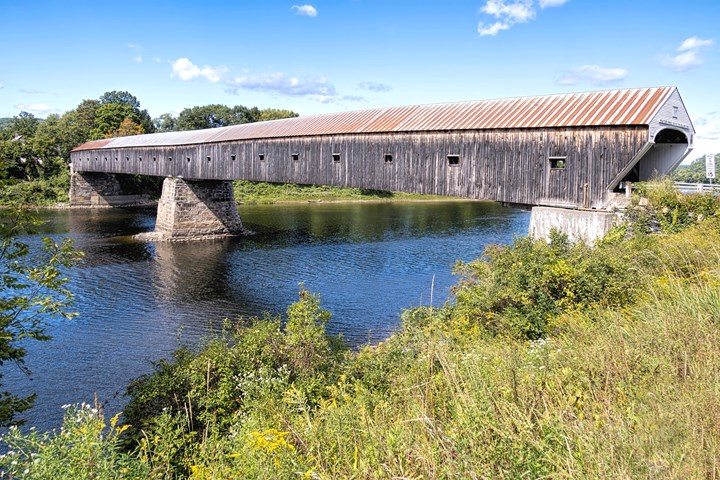
Of Covered Bridges and Recycling

This 156-year-old wooden covered bridge, the longest of its age in the U.S., led me back to my hometown in New Hampshire, where I was asked repeatedly about the plastics industry’s activities in recycling. (Photo: Matthew Naitove)
For me, it seems that all roads seem to lead to recycling lately, both literally and figuratively. In my last blog, the “road” was the canals of Venice. This time, it was the road over the longest “old” wooden covered bridge in the U.S., which spans the Connecticut River between Cornish, N.H., and Windsor, Vt. This bridge, over 449 ft long, was built in 1866. A longer one was built in Ohio in 2008, but to my mind a “newbie” like that doesn’t count. I’m a New Englander, you see, and I drove up to New Hampshire last month for my 55th high school reunion, which is how I encountered the Cornish-Windsor covered bridge.
That visit also precipitated multiple discussions of plastics recycling, since that was the first thing that came to my classmates’ minds whenever I answered the question, “You still writing about the plastics?” I was happy to tell them what an exciting subject recycling is these days and how excited the whole plastics industry is about it. I told them I have high hopes, in particular, for the fledgling technology of chemical recycling, which has the potential to greatly increase recovery rates of post-consumer waste by eliminating the thorny issues of how to identify and separate different kinds of plastics and break apart composites of different species of plastics. Most of my classmates seemed to be hearing this news for the first time.
Too bad I couldn’t have told them about an announcement that dropped into my email box this week, in which 12 member companies of The Consumer Goods Forum’s Coalition of Action on Plastic Waste expressing their wish to procure chemically recycled plastics produced in line with their guidelines on environmental safeguards. A wider survey of 22 Coalition member companies back in April indicated demand for nearly 1.6 billion lb of chemically recycled PE and PP by 2030, around 1.4 billion lb of that food grade. Meeting such demand would require 60 to 70 new medium-sized chemical recycling plants.
Read: Chemical Recycling Poised to Take Off
The CGF’s Plastic Waste Coalition has developed principles for “safe scaling of pyrolysis-based chemical recycling” in the belief that this technology “could increase packaging recycling rates, which could enable recyclability targets to be met, more specifically for hard-to-recycle plastics, for example post-consumer flexible film.” What’s more, “The Coalition recognizes that although chemical recycling technology is not a silver bullet, it will be an important technology which can serve a vital purpose the recycling of unavoidable plastic waste which cannot be otherwise recycled mechanically.”
The CGF Coalition of Action on Plastic Waste was founded in 2020 with the aim of developing a more circular approach to the development and processing of plastic packaging in the consumer goods industry. It’s a CEO-led group, now numbering 42 retailers and manufacturers, including Amcor, Barilla, Coca-Cola, Colgate-Palmolive, Danone, Ferrero, Henkel, Johnson & Johnson, L’Oreal, Mars, Merck, Mondelez, Nestlé, Pepsico, Procter & Gamble, Sainsbury’s SC Johnson, SIG, Tetra Pak, Unilever and Walmart. The Consumer Goods Forum includes senior management of some 400 retailers, manufacturers, service providers and other stakeholders across 70 countries.
RELATED CONTENT
-
Get to Know Lasers And Their Roles in Plastics
Plastics processing is one of the fastest growing application areas for laser technology.
-
They’ve Been Working on the Railroad
Composite RR ties could finally be on their way to becoming the next big thing in plastic lumber. They are attracting interest from makers of marine pilings, another category of structural wood replacements.
-
Thermoplastic Polyesters: It’s Time to Know Them Better
There’s more to TP polyesters than you think. You may know PET, PBT, and PETG—but what about PCT, PCTG, PCTA, and PTT? If you’re not sure what they are, how their properties compare, and who sells them, we have the answers—and lots of new developments to report.

Leave a Reply